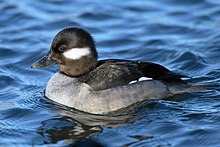Diamond Peak Wilderness
| Diamond Peak Wilderness | |
|---|---|
 Diamond Peakfrom thePacific Crest Trail | |
| Location | Klamath/Lanecounties,Oregon,United States |
| Nearest city | Oakridge, Oregon |
| Coordinates | 43°31′0″N122°9′0″W/ 43.51667°N 122.15000°W |
| Area | 52,337 acres (21,180 ha) |
| Established | 1964 |
| Governing body | U.S. Forest Service |
TheDiamond Peak Wildernessis awilderness areastraddling theCascadecrest and includes theDiamond Peakvolcano. It is located within two National Forests - theWillamette National Foreston the west and theDeschutes National Foreston the east.[1]
Designation
[edit]On February 5, 1957, the Forest Service established the 36,637-acre (14,826 ha) Diamond Peak Wild Area. Upon passage of the federalWilderness Actin 1964 it was reclassified as wilderness. With the passage of the Oregon Wilderness Act of 1984, Diamond Peak Wilderness increased in size to its present 52,337 acres (21,180 ha).[2]
Geography
[edit]
At 8,744 feet (2,665 m), Diamond Peak is the highest peak in the wilderness. The next highest named peaks are Mount Yoran at 7,100 feet (2,200 m) and Lakeview Mountain at 7,065 feet (2,153 m).[3][4]Diamond Peak is ashield volcanoformed as the entire Cascade Range was undergoing volcanic activity and uplift. Glaciers carved the large volcanic peak, and when they receded, the bulk of the mountain remained, with snowfields near the summit and dozens of small lakes surrounding the peak. These lakes range from one to 28 acres (11 ha) in size.[1]Approximately 14 miles (23 km) of thePacific Crest National Scenic Trailpass through this wilderness. Another 38 miles (61 km) of trail, including the 10-mile (16 km) Diamond Peak Trail, stretches the length of the west side of the peak.[1]
Vegetation
[edit]Nearly the entire Diamond Peak Wilderness is covered with mixed stands ofmountain hemlock,lodgepoleandwestern white pine,andsilver,noble and other truefirs.[1]Alpine flowers, including varieties ofmimulus,trillium,lupine,penstemon,heather,andIndian paintbrush,are common along trails, lake shores, streams and in the meadows.Huckleberryand dwarfmanzanitaare common in the dense underbrush.[2][5]
Wildlife
[edit]
The Diamond Peak Wilderness is home toblack-tailed deer,mule deer,andelk.In winter, the mule deer migrate eastward out of the wilderness to the sage desert, while black-tailed deer and elk drop down the west slope.Black bearand small mammals includingmarmots,snowshoe rabbits,squirrels,pine martens,foxes,andpikasinhabit the area all year long. Theraven,Clark's nutcracker,Oregon jay, andwater ouzelfrequent the forest and streams year-round.Buffleheadandgoldeneye ducksoccasionally nest near the lakes.[2][5]
Recreation
[edit]Recreational activities in the Diamond Peak Wilderness include hiking, horseback riding, camping, hunting, fishing, and mountain climbing. Some 52 miles (84 km) of trails cross the wilderness, including 14 miles (23 km) thePacific Crest Trailalong the east slope of Diamond Peak. Marie Lake, Divide Lake, and Rockpile Lake are popular base camps for the climb up Diamond Peak. Mount Yoran and Lakeview Mountain can also be climbed. Winter is popular for snowshoeing and cross-country skiing.[1][2]
See also
[edit]References
[edit]- ^abcde"Diamond Peak Wilderness: Willamette".U.S. Forest Service.RetrievedNovember 23,2014.
- ^abcdCentral Oregon Wilderness Areas (Cascades to the Coast),by Donna Aitkenhead, p4. 14-15
- ^Geo-Graphics; Deschutes National Forest; Willamette National Forest (2000).Willamette Pass Oregon XC Ski Trails: Salt Creek Falls to Crescent Lake Jct(Topographic map). 1:38,585. Geo-Graphics.
- ^U.S. Forest Service; Bureau of Land Management (2017).Willamette Cascades(Map). 1:126,720. Pacific Northwest Recreation Map Series.ISBN978162811578-9.
- ^ab"GORP - Diamond Peak Wilderness Area, Oregon".Archived fromthe originalon 2010-05-16.Retrieved2010-05-13.
External links
[edit]- Willamette National Forest- Diamond Peak Wilderness
- Deschutes & Ochoco National Forests- Diamond Peak Wilderness

